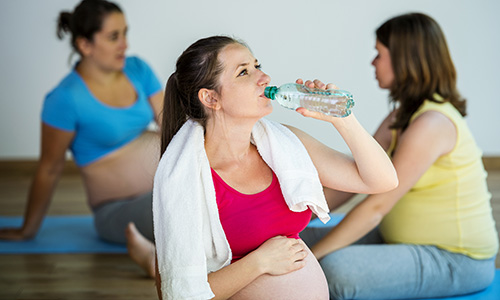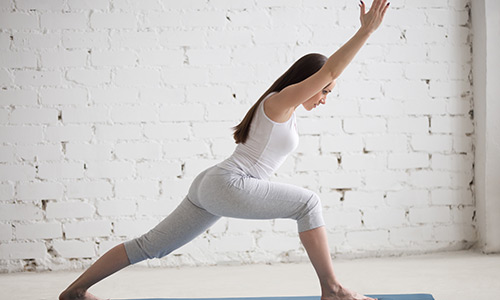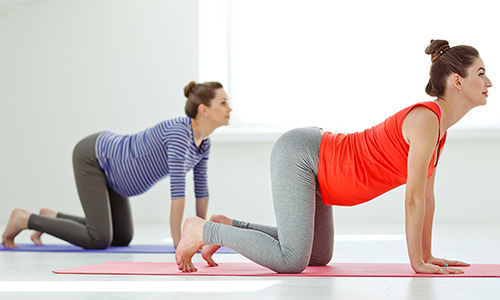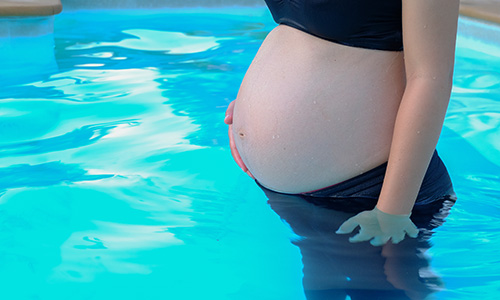Keeping fit during pregnancy
- Overview
Long gone are the days when pregnant women were expected to rest on their laurels for nine long months. Modern society has accepted that exercise during a normal pregnancy can have physical benefits for both mother and baby. But, understandably, some mums-to-be are anxious about exercising and want to know how to do it safely.
It's important to acknowledge that your body is changing dramatically during pregnancy. Many of the changes are invisible, but can have a big impact on your exercise regime. From early on in your pregnancy your body produces a hormone called relaxin, for example, which loosens all of the muscles in preparation for your change in shape. This makes your joints less stable and so you're more likely to suffer a sprain or other joint injury.

Research has found that for most pregnant women it is safe to exercise up to 80% of your maximum heartrate for regular exercisers and up to 70% for non-exercisers, this is around the 12-14 mark on the Borg scale. But exercise sessions should be limited to a maximum of 90 minutes.
It’s important to always check with your midwife before undertaking an exercise programme, but once you have the green light, exercise can help maintain your fitness and strength for once the baby is born. It has also been found to encourage blood flow and strength in the baby too.
Exercise in trimester 1
Listen to your body (and your Midwife)
Your desire and energy for exercise may fluctuate throughout your pregnancy. The first trimester in particular can leave you feeling exhausted, despite not ‘showing’. The body makes many physical and hormonal adaptations during this period which can lead to breathlessness, pains, intense emotions and feeling faint, to name a few. Not to mention the morning sickness that hits a lot of people during this first stage.
While exercise can actually help give you energy and can help ease the feelings of nausea in some women, you shouldn’t feel under pressure to exercise during pregnancy if you don’t feel up to it. Pregnancy is a delicate balance, and you should listen to your body.
What exercise programme you do at this point is also very much dependent on what level of exercise you were doing before you became pregnant. If you have a personal trainer, always inform them of your pregnancy (they won’t tell anyone else), as they will be able to make any necessary adaptations. Most people are OK to continue at their normal level of exercise in the first trimester, with the following restriction:
No valsalva manoeuvres – This means no movements that require you to hold your breath and push. It’s a good idea to reduce the weight that you lift, ensuring that it is submaximal - this means any weights you do should be of a level you can lift for 15 repetitions or more with good form.
Trimester 1 Programme
Here is an example week of exercise for your first trimester (check with your midwife before undertaking any exercise programme).
MONDAY - Brisk walk/run - 30 mins

TUESDAY - Stretching, yoga or pilates - 20 mins
WEDNESDAY - Cycling/Spin class - 20 mins + 2 x (15 Squats, 15 Kneeling Supermans, 15 Dumbbell Curls - each arm, 15 Dumbbell Rows - each arm)
THURSDAY - Rest
FRIDAY - Stretching, yoga or pilates - 20 mins
SATURDAY - Brisk walk/run - 30 mins + 2 x (15 Squats, 15 Kneeling Supermans, 15 Dumbbell Curls - each arm, 15 Dumbbell Rows - each arm)
SUNDAY - Gentle walk/jog - 20 mins
Exercise in trimester 2
Think about reducing impact
The second trimester is considered by most to be ‘the best one’, where you start to wear that pregnancy glow. The baby bump starts to show and as your baby grows there are a few new limitations to take into consideration when training.
If you are a regular runner this is the trimester when you may have to (begrudgingly) move your training away from regular running. This is because running causes pressure on your pelvic floor which is supporting your uterus. Regular pressure or impact on your pelvic floor can lead to injury. If you like running, you might want to consider aqua jogging as a substitute.
As your body shape changes you may also need to forgo the high impact classes, such as Grit, Insanity or Body Combat. You could substitute these classes for local specialist classes designed for pregnancy, which can be a good way to get to know other mothers-to-be in your area as well. Whatever class you take, always inform your instructor of your stage of pregnancy before the start of your class to allow them to inform you of any adaptations you might need to make.
Trimester 2 Programme
Here is an example week of exercise for your second trimester (check with your midwife before undertaking any exercise programme).
MONDAY - Brisk walk/aqua jogging - 30 mins
TUESDAY - Pregnancy yoga/pregnancy fit class - 30 mins

WEDNESDAY - Cycling (indoor only) - 20 mins or spin class + 3 x (15 Squats, 15 Kneeling Supermans, 15 Dumbbell Curls - each arm, 15 Dumbbell Rows - each arm)
THURSDAY - Rest
FRIDAY - Pregnancy yoga/pregnancy fit class - 30 mins
SATURDAY - Brisk walk/aqua jogging - 30 mins + 4 x (15 Squats, 15 Kneeling Supermans, 15 Dumbbell Curls - each arm, 15 Dumbbell Rows - each arm)
SUNDAY - Gentle walk - 30 mins
Exercise in trimester 3
Beware of your balance
There are classes that you can do right up to the very end of your pregnancy, with a few adaptations your instructors can show you. Things like Spin (on a static bike) or Body Pump can be continued but ask your instructor for suitable adaptations - you'll want to reduce the intensity and weights that you use.
From this point forward any prone or supine (laying on your front or back) exercises should be avoided. When you lie on your back or front your bump can put pressure on the vena cava, the vein that carries blood from the lower part of your body to the heart.
During the final trimester exercises involving balance and agility may become difficult due to the changes in posture and centre of gravity, so care should be taken to adapt any exercises involving these things.
Trimester 3 Programme
Here is an example week of exercise for your third trimester (check with your midwife before undertaking any exercise programme).
MONDAY - Cross trainer/rowing/swimming - 30 mins

TUESDAY - Pregnancy yoga/pregnancy fit class - 30 mins
WEDNESDAY - Cycling (indoor only) - 20 mins or spin class + 2 x (15 Narrow-leg Squats, 15 Kneeling Supermans, 15 Dumbbell Curls - each arm, 15 Dumbbell Rows - each arm)
THURSDAY - Rest
FRIDAY - Pregnancy yoga/pregnancy fit class - 30 mins
SATURDAY - Cross trainer/rowing/swimming - 30 mins + 2 x (15 Narrow Leg Squats, 15 Kneeling Supermans)
SUNDAY - Gentle walk - 20 mins
Warning signs
If you experience any of the following, exercise should be stopped and you should seek medical attention:
- Vaginal bleeding
- Feeling faint prior to exercise
- Dizziness
- Headache
- Chest pain
- Muscle weakness
- Calf pain or swelling
- Preterm labour
- Decreased foetal movement
- Amniotic fluid leakage.
Last updated Monday 2 July 2018
First published on Thursday 4 August 2016

